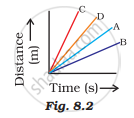Advertisements
Advertisements
Question
An ant travels a distance of 8 cm from P to Q and then moves a distance of 6 cm at right angles to PQ. Find its resultant displacement.
Solution 1
We have to find the resultant displacement from the given diagram :

We have:
PQ = 8 cm and QR = 6 cm
Resultant displacement :
`PR = sqrt(PQ^2 + QR^2)`
= `sqrt(64+36)`
= `sqrt(100)`
= 10 cm
The direction of this displacement is from P to R. If θ is the angle made by PR with PQ then,'
`tan θ = "RQ"/"PQ"`
⇒ `tan θ = 36/64`
⇒ `θ = tan^-1 0.5625`
⇒ `θ = 29.36^circ`
This is the angle made by the resultant with PQ.
Solution 2
To find the resultant displacement, we treat the movement of the ant as forming a right triangle, where:
- The distance from P to Q is 8 cm (one leg of the triangle).
- The distance moved at a right angle to PQ is 6 cm (the other leg of the triangle).
The resultant displacement is the hypotenuse of this right triangle, which can be calculated using the Pythagorean theorem:
Resultant displacement = `sqrt((8^2 + 6^2)`
Resultant displacement = `sqrt(64+36) = sqrt100 = 10 cm.`
The resultant displacement is 10 cm.
APPEARS IN
RELATED QUESTIONS
A farmer moves along the boundary of a square field of side 10 m in 40 s. What will be the magnitude of displacement of the farmer at the end of 2 minutes 20 seconds?
Under what conditions can a body travel a certain distance and yet its resultant displacement be zero ?
The displacement of a moving object in a given interval of time is zero. Would the distance travelled by the object also be zero ? Give reason for your answer.
If the displacement of an object is proportional to the square of time, then the object is moving with :
Clarify the difference.
Distance and displacement
Calculate the distance and displacement in the following case:
The table below shows the distance travelled by two vehicles A and B during each second:
| Time (s) | 0 | 1 | 2 | 3 | 4 | 5 | 6 | 7 |
| Distance travelled by A (m) | 0 | 20 | 80 | 180 | 240 | 300 | 360 | 420 |
| Distance travelled by B (m) | 0 | 10 | 40 | 90 | 160 | 250 | 360 | 490 |
Which vehicle is ahead at the end of 7th second and by how much?
Distance travelled by a body in a given time ______.
Four cars A, B, C, and D are moving on a levelled road. Their distance versus time graphs are shown in Fig. 8.2. Choose the correct statement.

The displacement of a moving object in a given interval of time is zero. Would the distance travelled by the object also be zero? Justify your answer.
